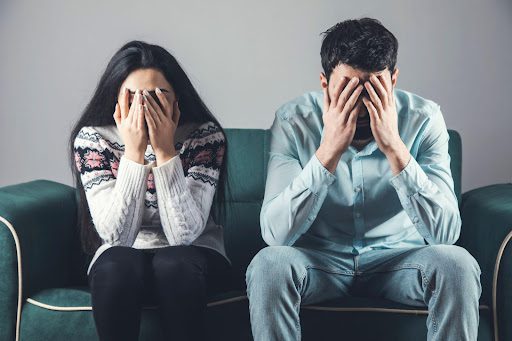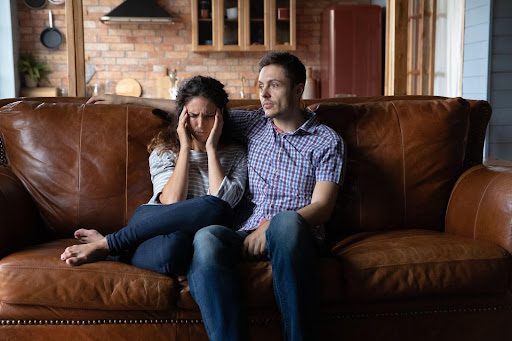The detrimental symptoms of a mental health disorder can cause those experiencing them a great deal of suffering. But while the symptoms of individual cases are widely covered and discussed in professional literature, research addressing cases of a depressed couple, for instance, are few and far between. Yet despite the scarcity of such documented cases, couples dealing with depression—or anxiety, or a number of other mental health disorders—do exist, and their experiences should also receive the attention necessary for them to identify their shared issues and begin to heal. Read on to find out about couples with mental health issues, and about how such shared experiences might manifest themselves.
At its core, mutual mental health disorders, among couples or within other types of relationships, refers to cases where more than one individual shares a mental health experience, which many times can lead to harmful effects. It should also be stressed that not all affective concordance may lead to mental illness, and that only cases where shared emotional states become detrimental should be considered as possible instances of a shared mental health disorder.

Out of the various types of mutual mental health disorders, or cases of affective concordance, one type of shared disorder has been granted a rather prominent place in the study of mental health: folie à deux. The mental health disorder refers to instances of shared psychosis, where the same delusions are usually experienced by members of the same family.
Up until 2013, folie à deux was officially recognized by the American Psychiatric Association (APA) as a distinct mental health disorder in its own right. However, folie à deux was removed from the APA’s fifth edition of its Diagnostics and Statistical Manual (DSM-V). Its removal was due to insufficient evidence that made such a shared disorder uniquely different from two individuals having the same disorder as one another. For this reason, cases that would have been previously defined as folie à deux are now referred to as two instances of delusional disorder.
Treatments and interventions such as antipsychotic medication, separating the relevant family members from one another, individual and family therapy, may offer patients with this condition symptom relief.
Couples have been shown to more often suffer from the same mental health disorder as their spouse, when compared to non-couples among the general population. Directionality was also found among couples, so that the existence of a mental health disorder among one spouse can act as a predictor for the same disorder among the second spouse.
Research also points to a noticeable increase in prevalence for the two most common types of mental health disorder—anxiety and depression—when one’s partner has the same condition. Specifically, studies have shown that a woman in a relationship with a man who has anxiety are three times more likely to face anxiety themselves.
Women in a relationship with men who have depression were over four times more likely to experience depression. This in addition to women being one and a half-to-three times more likely to experience depression than men. Together, these findings suggest that depression among married couples is far more likely to exist.
Several environmental factors for the higher prevalence of shared mental health issues among couples have been uncovered. Among them is the crucial role that one’s family often plays in their available support system: for many individuals, the family unit is the most immediate and central source of support when dealing with emotional issues. If members of their family, and specifically their spouse, are prone to the same vulnerability as the individual facing a certain disorder, their partner’s condition may act as a trigger for the aforementioned spouse, causing their relationship to negatively impact both partners’ sense of well-being.
Seen from another angle, the mental health costs of becoming the central caregiver to one’s partner can in itself bring on mental health symptoms, at times reflecting the same ones their partner is suffering from. For this reason, it is imperative, when possible, to provide external care and services to one’s spouse, and not contain their treatment and overall care within their spousal relationship or family unit.
One partner’s mental health disorder can similarly begin to affect both partners when existing marital issues are already in place. This has particularly been shown to be true in cases of depression.
Shared, high-stress occupation among spouses is yet another explanation for detrimental concordance. Soldiers and veterans, for instance, both of whom have a higher likelihood of developing anxiety disorders, households with either vocation are also significantly more likely to have shared mental health disorders.

Both the original patient and the caregiver-turned-patient in a romantic relationship deserve empathy and professional care. As such, it is important for both partners to seek out the type of treatment that could meet their needs, and develop a support network they can rely on when looking to benefit their own mental health, and that of their loved one.
Available treatments for partners and primary caregivers include dedicated support groups, psychopharmacological treatment, psychotherapy, and medical device treatments. Changing one’s environment through diet and exercise can also improve their well-being. And finally, remembering they, too, deserve attention and care, is also an important part of their family’s well-being.